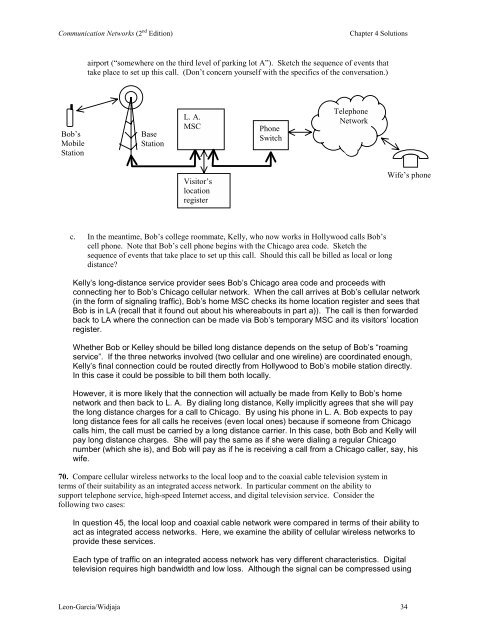Solutions to Chapter 4 - Communication Networks
Solutions to Chapter 4 - Communication Networks
Solutions to Chapter 4 - Communication Networks
You also want an ePaper? Increase the reach of your titles
YUMPU automatically turns print PDFs into web optimized ePapers that Google loves.
<strong>Communication</strong> <strong>Networks</strong> (2 nd Edition)<br />
<strong>Chapter</strong> 4 <strong>Solutions</strong><br />
airport (“somewhere on the third level of parking lot A”). Sketch the sequence of events that<br />
take place <strong>to</strong> set up this call. (Don’t concern yourself with the specifics of the conversation.)<br />
Bob’s<br />
Mobile<br />
Station<br />
Base<br />
Station<br />
L. A.<br />
MSC<br />
Phone<br />
Switch<br />
Telephone<br />
Network<br />
Visi<strong>to</strong>r’s<br />
location<br />
register<br />
Wife’s phone<br />
c. In the meantime, Bob’s college roommate, Kelly, who now works in Hollywood calls Bob’s<br />
cell phone. Note that Bob’s cell phone begins with the Chicago area code. Sketch the<br />
sequence of events that take place <strong>to</strong> set up this call. Should this call be billed as local or long<br />
distance<br />
Kelly’s long-distance service provider sees Bob’s Chicago area code and proceeds with<br />
connecting her <strong>to</strong> Bob’s Chicago cellular network. When the call arrives at Bob’s cellular network<br />
(in the form of signaling traffic), Bob’s home MSC checks its home location register and sees that<br />
Bob is in LA (recall that it found out about his whereabouts in part a)). The call is then forwarded<br />
back <strong>to</strong> LA where the connection can be made via Bob’s temporary MSC and its visi<strong>to</strong>rs’ location<br />
register.<br />
Whether Bob or Kelley should be billed long distance depends on the setup of Bob’s “roaming<br />
service”. If the three networks involved (two cellular and one wireline) are coordinated enough,<br />
Kelly’s final connection could be routed directly from Hollywood <strong>to</strong> Bob’s mobile station directly.<br />
In this case it could be possible <strong>to</strong> bill them both locally.<br />
However, it is more likely that the connection will actually be made from Kelly <strong>to</strong> Bob’s home<br />
network and then back <strong>to</strong> L. A. By dialing long distance, Kelly implicitly agrees that she will pay<br />
the long distance charges for a call <strong>to</strong> Chicago. By using his phone in L. A. Bob expects <strong>to</strong> pay<br />
long distance fees for all calls he receives (even local ones) because if someone from Chicago<br />
calls him, the call must be carried by a long distance carrier. In this case, both Bob and Kelly will<br />
pay long distance charges. She will pay the same as if she were dialing a regular Chicago<br />
number (which she is), and Bob will pay as if he is receiving a call from a Chicago caller, say, his<br />
wife.<br />
70. Compare cellular wireless networks <strong>to</strong> the local loop and <strong>to</strong> the coaxial cable television system in<br />
terms of their suitability as an integrated access network. In particular comment on the ability <strong>to</strong><br />
support telephone service, high-speed Internet access, and digital television service. Consider the<br />
following two cases:<br />
In question 45, the local loop and coaxial cable network were compared in terms of their ability <strong>to</strong><br />
act as integrated access networks. Here, we examine the ability of cellular wireless networks <strong>to</strong><br />
provide these services.<br />
Each type of traffic on an integrated access network has very different characteristics. Digital<br />
television requires high bandwidth and low loss. Although the signal can be compressed using<br />
Leon-Garcia/Widjaja 34







